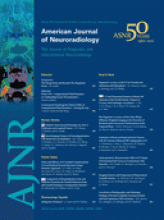Abstract
BACKGROUND AND PURPOSE: Radiologic methods for the diagnosis of chemical radiculitis associated with anular tears in the lumbar spine have been rare. Provocative diskography is one of the methods for diagnosing diskogenic chemical radiculitis but is invasive. A reliable imaging method for replacing provocative diskography and diagnosing chemical radiculitis is required. Our aim was to investigate the value of 3D MR radiculography depicted by rendering imaging in the diagnosis of symptomatic chemical radiculopathy associated with anular tears.
MATERIALS AND METHODS: The study population consisted of 17 patients (age range, 32–88 years) with unilateral radiculopathy. Symptomatic chemical radiculopathy was confirmed with provocative CT diskography and/or provocative selective nerve root block for agreement of sides and levels. Through adhering to the principles of selective excitation (Proset imaging), we acquired 3D coronal FFE sequences with selective water excitation. Morphologic changes in the ipsilateral symptomatic nerve root caused by chemical radiculopathy were compared with those in the contralateral nerve root on 3D MR lumbosacral radiculography.
RESULTS: Pain reproduction at the contrast-leak level during diskography (n = 4) and selective nerve root injection (n = 13) showed concordant pain in all patients. All patients with symptomatic chemical radiculopathy showed nerve root swelling in both ipsilateral levels and sides on 3D MR radiculography. The most common nerve root affected by the chemical radiculopathy was the L5 nerve root (n = 13), while the most common segment exhibiting nerve root swelling was the exit nerve root (n = 16).
CONCLUSIONS: All patients with radicular leg pain caused by chemical radiculopathy showed nerve root swelling on 3D MR radiculography. We believe that in cases without mechanical nerve root compression caused by disk herniation or stenosis in the lumbar spine, nerve root swelling on 3D MR radiculography in patients with radiculopathy associated with an anular tear may be relevant in the diagnosis of symptomatic chemical radiculopathy.
ABBREVIATIONS:
- DRG
- dorsal root ganglia
- FFE
- fast-field echo
- HIZ
- high-intensity zone
- MPR
- multiplanar reformations
- PLA2
- phospholipase A2
- SIR
- signal-intensity ratio of the nerve root to the paraspinal muscle
- © 2012 by American Journal of Neuroradiology












